 Meisterburger Meisterburger
The Homemade Hamburger Revisited
by Nicholas Robinson
A good burger can be the tastiest meal on this planet. A bad burger can be unfit for roaming pack animals. I have had both, many, many times.
One thing I have noticed is that many of us throw ourselves to the mercy of others when it comes to hamburgers; we rarely make them at home because they are “too difficult,” so we subject ourselves to McDonald’s, Burger King and Wendy’s, among many others.
I am not knocking these burgers, but allow me to say that these offerings are to the spirit of the hamburger as grape juice is to Cabernet, or Cheese Whiz is to Vacherin mont d'or. At the opposite end of the scale, Daniel Boulud, chef-of-the-moment, created something called the “DB Burger Royale”, which is constructed as follows: Standing 4 inches tall and 4 inches across, it consists of braised short ribs and foie gras tucked into the burger, which is pan-seared to a crusty finish; ground horseradish and French mustard; curly chicory and tomato confit on top and fresh tomato underneath; and layers of freshly shaved black Provençal truffles - top, bottom and in between. This will cost you around US$41.
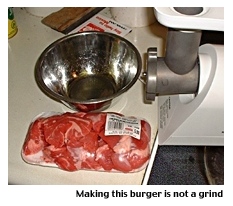 This to me is grand overkill. The addition of unusual ingredients and toppings only serves to obscure the spirit of the hamburger, whose origins can be attributed to either Mongol Tartars, German immigrants or some schlub in Hamburg, N.Y. A hamburger need not be pet food nor posh food. This to me is grand overkill. The addition of unusual ingredients and toppings only serves to obscure the spirit of the hamburger, whose origins can be attributed to either Mongol Tartars, German immigrants or some schlub in Hamburg, N.Y. A hamburger need not be pet food nor posh food.
With a little effort and a lot of love, you can make yourself a great burger so far removed from fast food that anyone tasting it will vow that it is the best hamburger they have ever eaten, bar none, and you can cook it in your own home without using a barbecue or grill. And yes, I am willing to wager.
Where do I come off claiming that this is “one of the best” recipes for a home-made burger? Years of cooking and years of mistakes, coupled with plenty of research, have led me to believe that the key to good burger making is to have the finest-quality ingredients available—not necessarily gourmet or hard-to-find ingredients—and to prepare them with care and an eye for detail.
What are the basics for a good homemade burger?
1. Fresh ground beef
2. Fresh hamburger rolls
3. Fresh vegetable toppings
4. Fresh sauce
5. High-quality add-ons (cheese, bacon etc.)
Let us start with the heart of the burger.
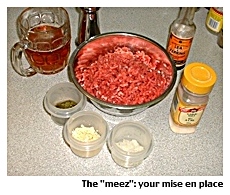 Obviously, you begin with an inferior product when you buy ground beef at the store. You have no idea where it came from, for one, and you have no idea how long it’s been sitting there. So Rule #1 is either ask your butcher to grind your selection for you in front of you, or purchase a meat grinder. If you have any intention of making burgers (or grinding any meats) on a regular basis, I suggest investing in a home meat grinder. You will not regret it, and it need not break your bank.
Obviously, you begin with an inferior product when you buy ground beef at the store. You have no idea where it came from, for one, and you have no idea how long it’s been sitting there. So Rule #1 is either ask your butcher to grind your selection for you in front of you, or purchase a meat grinder. If you have any intention of making burgers (or grinding any meats) on a regular basis, I suggest investing in a home meat grinder. You will not regret it, and it need not break your bank.
For the bread, you are probably at the mercy of your local purveyor. I have not yet made my own hamburger rolls, but I am mulling various recipes and no doubt will try it soon. However, we want to keep the making of your homemade burger to an acceptable level of simplicity, so we will for now assume that barring your making your own, you will buy the finest hamburger rolls available.
For the vegetables, I recommend only the best lettuce and the highest quality onions and tomatoes (more on this later.)
For the sauce—notice I do not say “ketchup”—a recipe will follow.
Cheese recommendations will also follow.

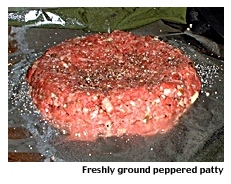 Recipe for 4 hamburgers of 150 grams (about a third of a pound) each: Recipe for 4 hamburgers of 150 grams (about a third of a pound) each:
Meat: About 1.5 pounds of stew meat, brochette meat or cubes for boeuf Bourgignon (the name of this will vary according to region), trying to make sure that the fat ratio is about 20%. You shouldn’t be making burgers if you are on a diet or prefer ultra-lean ground beef.
Rolls: The best hamburger rolls you can find. In my case I am limited to white bread sesame rolls. I would prefer a freshly-baked sourdough kaiser roll with onion, sesame and poppy seed, but it looks like if I want this, I will have to bake it myself. I’ll keep you posted.
Vegetables: A good, sweet red onion. The inner parts of a head of romaine, green or red frizzled-leaf lettuce. Do not put iceberg lettuce on a hamburger. This is a crime.
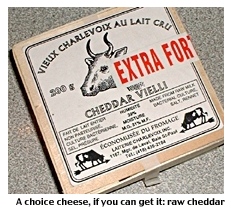 Condiments: A high-quality mayonnaise—do not use Miracle Whip—good ketchup, white wine vinegar and sweet pickled gherkins.
Condiments: A high-quality mayonnaise—do not use Miracle Whip—good ketchup, white wine vinegar and sweet pickled gherkins.
Extras: For cheese, select a good semisoft to semifirm cheese; this can be Swiss, an aged Cheddar, an Asiago or Provolone, or even a combination. For tamer tastebuds Jack or Mozzarella will suffice. Some enjoy soft, pungent cheeses such as Bleu or Roquefort, but I find these detract too much from the burger taste and overwhelm it.
If you want bacon, try to select a thicker cut than usual. If you have access to a butcher, ask her for the thick-cut variety.
Step 1: Grind the meat.
When the meat is ground, immediately refrigerate. By the time it has been ground it will probably have reached a temperature that is close to unsafe for further manipulation immediately. You want to cool it back down to refrigerator temperature, probably for 15-30 minutes. This will also give you time to clean the grinder and prepare the filler:
Step 2: Dress the burger.
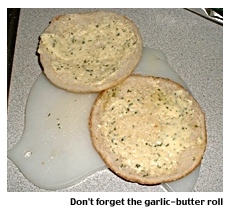 Finely chop one or two large shallots. If you can’t get shallots, a couple of finely-chopped cloves of garlic and a quarter cup of finely-chopped red onion will do. If you want a small kick to your burger, chop about two tablespoons of pickled jalapenos. When the hamburger has finished chilling, add the diced vegetables. Add about 4 T of Worcestershire sauce. Add about 1 Tsp of salt; garlic salt is best. This might seem to be a lot of salt, but your burger will taste better. Trust me. Then add about 1 Tsp of coarsely-ground fresh black pepper. If you want added kick, add about 1/2 Tsp. of fresh cayenne. Finely chop one or two large shallots. If you can’t get shallots, a couple of finely-chopped cloves of garlic and a quarter cup of finely-chopped red onion will do. If you want a small kick to your burger, chop about two tablespoons of pickled jalapenos. When the hamburger has finished chilling, add the diced vegetables. Add about 4 T of Worcestershire sauce. Add about 1 Tsp of salt; garlic salt is best. This might seem to be a lot of salt, but your burger will taste better. Trust me. Then add about 1 Tsp of coarsely-ground fresh black pepper. If you want added kick, add about 1/2 Tsp. of fresh cayenne.
With ground beef this fresh, you do not need fillers or binding agents such as eggs or breadcrumbs. Loosely combine everything with a fork. Don’t crush the ground beef into a paste. Just make sure everything is throughly mixed.
 Step 3: Shape the burger. The way I make individual burgers is with a metal half-cup measure. I scoop up about a half-cup of ground meat in the measure and then tamp it lightly down with a fork. Then I upend it onto some aluminum foil sprayed with Pam spray. Then, using a wide, flat spatula, either metal or plastic, I push down the cylinder of ground beef to a large, round disk about 4 inches in diameter. I tidy up the edges with my fingers or the spatula. Then, I indent the center of the disk slightly with a spoon or fingers. This will make sure that when the burger shrinks, it won’t turn into a convex “fatburger” shape. Now I refrigerate the individual patties in their aluminum foil after sprinkling the up side with some additional salt and cracked pepper.
If you double, triple or quadruple this recipe, you can put the patties in the freezer. Be careful for freezer burn, however; when these individual patties have frozen hard, I will put them in airtight Ziploc bags. Better yet is a Foodsaver bag; this is based on a vacuum system that will preserve your frozen burgers (and other frozen items) for up to a year unscathed. Freezer burn (that white frost-like material on frozen stuff) will kill your fresh burger deader than ground particle board. I have found that burgers frozen for more than a month or two become brittle and tend to fall apart on the grill or frying pan, so label your frozen treasures well. Step 3: Shape the burger. The way I make individual burgers is with a metal half-cup measure. I scoop up about a half-cup of ground meat in the measure and then tamp it lightly down with a fork. Then I upend it onto some aluminum foil sprayed with Pam spray. Then, using a wide, flat spatula, either metal or plastic, I push down the cylinder of ground beef to a large, round disk about 4 inches in diameter. I tidy up the edges with my fingers or the spatula. Then, I indent the center of the disk slightly with a spoon or fingers. This will make sure that when the burger shrinks, it won’t turn into a convex “fatburger” shape. Now I refrigerate the individual patties in their aluminum foil after sprinkling the up side with some additional salt and cracked pepper.
If you double, triple or quadruple this recipe, you can put the patties in the freezer. Be careful for freezer burn, however; when these individual patties have frozen hard, I will put them in airtight Ziploc bags. Better yet is a Foodsaver bag; this is based on a vacuum system that will preserve your frozen burgers (and other frozen items) for up to a year unscathed. Freezer burn (that white frost-like material on frozen stuff) will kill your fresh burger deader than ground particle board. I have found that burgers frozen for more than a month or two become brittle and tend to fall apart on the grill or frying pan, so label your frozen treasures well.
Step 4: Prepare the rolls.
I find that about a tablespoon of garlic butter divided between the two rolls adds an indefinably rich taste to the whole package. If making from scratch, combine four tablespoons of salted butter with two finely-chopped garlic cloves and about a tablespoon of chopped parsley. Melt in the microwave on low until soft, about 30 seconds to a minute. Spread with a spoon or knife on each side of the rolls. If you can get already-made garlic butter (I can) use the microwave to soften, then proceed.
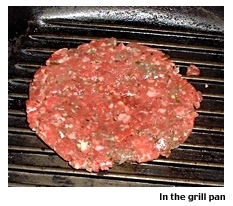 Step 4: Make the sauce. Step 4: Make the sauce.
Combine about four tablespoons of ketchup with four tablespoons of mayonnaise. Mustard can also be included. Add about a tablespoon of white vinegar. Finely chop one or two sweet gherkins and stir into the sauce. Crack about 1/2 a teaspoon of pepper in. Combine thoroughly.
Step 5: Prepare the vegetables.
Slice the red onion into 1/4-inch thick slices. You want a good crunch to the burger. Separate the lettuce so that only the good, crunchy inner leaves are ready for the burger. Slice a fresh, vine-ripened tomato very thinly into several slices with a very sharp knife. If you slice the tomato too thickly, it will end up on your lap, not to mention make the burger drip-drip-drip.
Step 5: Prepare the cheese and/or bacon. Slice your cheese into 1/4-inch thick slices. Either roast the bacon in the oven on aluminum foil on 500 for 12 minutes or sauté in a pan. Set aside.
 Step 5: Heat your grill pan on MEDIUM heat for six minutes (lots of folks think you have to heat a grill pan on high. Don’t do this! You might melt your stove.) Do not grease up your grill pan! That means no non-stick spray, either! The grease will be on the food.
Step 5: Heat your grill pan on MEDIUM heat for six minutes (lots of folks think you have to heat a grill pan on high. Don’t do this! You might melt your stove.) Do not grease up your grill pan! That means no non-stick spray, either! The grease will be on the food.
If you don’t have a grill pan, you will end up with a lesser (not to mention more fattening) burger. Get a grill pan. It will come in handy for dozens of dishes.
When the grill pan is ready, pop the hamburger rolls, open sides up, into the toaster oven on about 450. Then plop the burgers down on the grill pan. You will probably have only room for two for both tasks. No problem, do them in shifts.
The burgers will be ready in about 6 minutes, so turn them at three. Watch the rolls carefully so that they don’t get charred. When you flip the burgers, add the cheese on top. It should be almost melted by the time they are ready.
You’re ready to assemble the burgers.
Put the bottom rolls on a plate. Add the burger patties. Spread the patties with a generous amount of mayonnaise/ketchup sauce. Add slices of bacon (I always forget!) at this point if you are adding them. Add a thick slice of onion. Add tomato slices to taste. Add as much crisp lettuce as will fit on the burger. Top with the top of the hamburger roll. Push the whole creation down firmly with the heel of your hand so everything doesn’t topple.
Serve the best burger you ever made.
Notes: This may seem to be an awfully complicated recipe for a simple burger. After all, you can buy some ground beef at the store, shape it in 15 seconds, schlep it into the frying pan and slap that onto a hamburger roll, add some ketchup and eat. This is a crime against hamburgers. Eating fast-food versions of this fantastically tasty dish should also be a crime.
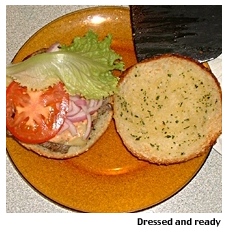 But what if . . . . ? But what if . . . . ?
Q. What if I don’t have a meat grinder?
A. Buy one. Or ask your butcher to grind your selection of meat for you.
Q. What if I don’t have a grill pan?
A. Buy one. If you are lucky enough to have a grill/barbecue and it isn’t -12 outside, cook it there. In a pinch, pan-fry it (not recommended).
Q. What if I don’t eat meat? Can I do this with tofu?
A. You can do this with tofu. Just don’t complain to me afterwards.
Q. Can I add stuff, like mushrooms?
A. Mushrooms on a hamburger are an abomination. If you must add them, use Deadly Nightshade.
Q. You’re not a real chef, are you?
A. No, but I have a large chef’s knife. That makes me a chef, doesn’t it? Well?
--by Nicholas Robinson
|
|
